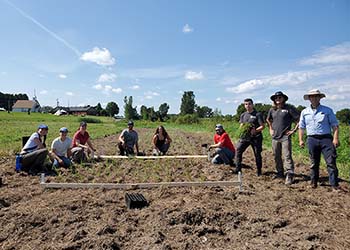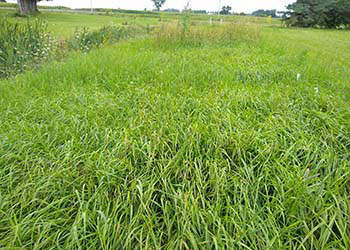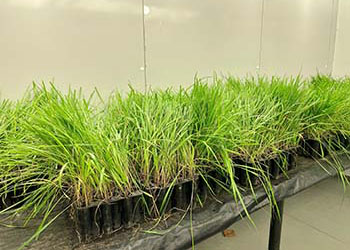Set up an interview
Media Relations
Agriculture and Agri-Food Canada
1-866-345-7972
aafc.mediarelations-relationsmedias.aac@agr.gc.ca
Sweetgrass (Hierochloe odorata) is a sacred herb for many North American First Nations. It is of great cultural, spiritual and cosmological importance. Called Wli Msikois in the W8banaki language, it is used as a medicinal plant in various ceremonies, as well as for basketry and for making various handicrafts. Previously found in abundance on the traditional territory of the W8banaki Nation, known as the Ndakina, it is now much rarer.
Indeed, the W8banaki note that the presence of sweetgrass has been considerably reduced on the Ndakina, mainly as a result of the intensification of agricultural activity and the effects of climate change on its habitat. In addition, because they are grasses, sweetgrass inventories are difficult to carry out, and very few Western scientific studies have focused on this species.
A collaboration that respects the values of the W8banaki Nation
An activity was co-developed and ran from 2020 to 2023 as part of the Living Lab – Quebec with the W8banaki Ndakina Office (the tribal council of the W8banaki Nation) under the supervision of its climate change adaptation project officer, Nicolas Pinceloup, and the Agriculture and Agri-Food Canada (AAFC) research teams of Jacynthe Masse, Martin Chantigny and Jean-Philippe Parent. Its main objective was to reintegrate sweetgrass into the traditional territory of the W8banaki Nation, so that members of the First Nations of W8linak and Odanak could regain access to this plant. The teams also wanted to study its ecological effects, including its impact on soil health, carbon sequestration and ecosystem biodiversity.
As part of the living laboratory activity, conversations were held with members of the Nation who make basketry or other products from sweetgrass. The art of basket-making is intimately linked to the W8banaki way of life. It consists in making woven objects from plant fibres and stems such as sweetgrass. It is not only an ancestral practice, but also an ongoing tradition that lies at the heart of the Nation's identity and history.
The W8banaki Nation has a deep relationship with sweetgrass and hold a great deal of traditional ecological knowledge about it. This knowledge is protected and restricted within the W8banaki culture, and cannot be shared freely. Similarly, the non-commercialization of this knowledge is a limit that must be respected at all costs.
"In this Living Laboratory activity, the Nation dictates the objectives and limits. Giving community members back access to this plant in a way that respects Indigenous values and that is as transparent as possible in terms of communication was the primary goal. Once we've achieved that, everything else is a bonus."
- Nicolas Pinceloup, Climate Change Adaptation Project Officer, W8banaki Ndakina Office
In 2022, nearly 4,000 plants were planted at W8linak and on AAFC's L'Acadie Experimental Farm. The majority of the plots were dedicated to living laboratory activities co-developed by the Department and the Nation to identify the best techniques for restoring sweetgrass on the territory and to study the plant's potential benefits for the agroecosystem, soil health, biodiversity and carbon sequestration. A community plot was made available to members of the Nation. A small plot has also been set up, with the Nation's agreement, at the home of a neighbouring allochthonous agricultural producer whose facilities were conducive to this activity. In 2023, some 3,750 additional plants were added through new plantings on AAFC's L'Acadie and Frelighsburg Experimental Farms.
Ecological benefits of sweetgrass studied
Scientific planting of sweetgrass took place in three different areas, at W8linak and AAFC's L'Acadie and Frelighsburg Experimental Farms, which represent three different environments in terms of both climate and soil type. For this first exploratory phase of the activity, two very simple practices were selected to test a revegetation strategy for sweetgrass: manual weeding and no human intervention. A number of plant parameters were studied, including the above-ground biomass of sweetgrass produced, the presence of weeds, above- and below-ground biodiversity, carbon sequestration and soil health. The objectives were to identify and develop restoration techniques that work, and to better understand the potential benefits of the plant for the agroecosystem with a view to possible use by the agricultural sector.
"I wanted to do research with a human dimension in addition to ecological objectives. Agriculture goes far beyond food. Both producers and Indigenous partners can benefit from tools to improve their production systems. The best way to do this is to work together."
- Jacynthe Masse, scientist at AAFC's Saint-Jean-sur-Richelieu Research and Development Centre and head of the sweetgrass research activity as part of Living Lab – Quebec
The Living Laboratory Project – Quebec
The former project, the Living Laboratories Initiative, which ran from 2018 to 2023, proposed a new way of approaching agricultural innovation in Canada. This method brings together farmers, scientists and local partners to develop and test innovative practices and technologies to solve agri-environmental challenges, including mitigating and adapting to climate change, protecting soil and water health, and enhancing biodiversity in agricultural landscapes.
In Quebec, an initial living laboratory project, Living Lab – Quebec, conducted by the Union des producteurs agricoles, took place in three watersheds in the Lake Saint-Pierre region between 2020 and 2023. The project's priority issues were soil health, water quality and biodiversity. Rather than looking at each issue in isolation, a holistic approach was adopted to provide an overview of the situation in the fields.
The sweetgrass activity was one of the components of Living Lab – Quebec, with the W8banaki Nation as a partner. The teams involved were able to establish a link and a dialogue of equals to explore an opportunity to share the territory and its resources while respecting the Nation. This is the very essence of the innovation favoured by the Living Labs approach. This research component was innovative in its collaborative approach with the W8banaki Nation, a first in the agro-ecosystem of the Lake Saint-Pierre region.
During the first exploratory phase of the activity, the research teams found that, with minimal plot maintenance and tillage to eliminate the seed bank of other plants, sweetgrass plants were able to establish and proliferate well in flood-prone and flooded areas near rivers. Sweetgrass plants were also donated to the Odanak First Nation, where they successfully proliferated. A first harvest in the fall of 2023 enabled the First Nation to make braids.
Growing interest among many First Nations in this type of collaboration
Traditional Indigenous territories face environmental challenges. In addition to the loss of sweetgrass on them, the two rivers near the W8linak and Odanak First Nations are victims of erosion. The process of bank degradation, also known as erosion, affects landforms, rocks and coastlines. It is caused by a number of factors, including agricultural practices. With shoreline restoration a priority, the W8linak and Odanak First Nations also wanted to validate whether sweetgrass could help reduce erosion, in addition to capturing carbon and increasing biodiversity in agroecosystems.
"For scientific communities to reach out to First Nations in a spirit of collaboration, it is essential to implement this type of initiative. However, it is imperative to leave room for First Nations members to express themselves on the issues encountered, to share as well as to participate during all stages of the activity to ensure a healthy collaboration with the community in order to build a bond of trust that has too often been broken."
- Isaak Lachapelle-Gill, Abenaki of Odanak and Territory Warden of the Ndakina Office of W8banaki
The first foundations of a knowledge community were also laid through this activity, enabling the various Indigenous Nations in Quebec to exchange ideas on the use of sweetgrass and various challenges. These exchanges were made possible thanks to the collaboration of the W8banaki Nation, the First Nations of Quebec and Labrador Sustainable Development Institute.
Discussions have begun among AAFC and several other Indigenous Peoples with a view to replicating this activity on other territories. Of course, interests, concerns and approaches will vary according to the specific objectives of each First Nation. Thousands of other plants are expected to be planted in the near future as a result of this collaboration.
Next steps
The sweetgrass activity will continue and grow thanks to AAFC's new Agricultural Climate Solutions - Living Labs program. In fact, the project led by the Union des producteurs agricoles, Laboratoire vivant - Racines d'avenir (in French only), includes an innovation cell entirely dedicated to the ecological restoration, preservation and reappropriation of sweetgrass in the St. Lawrence Valley. This innovation cell is co-developed by the W8banaki Nation and AAFC, with co-principal investigators Nicolas Pinceloup and Jacynthe Masse, the AAFC research teams of Martin Chantigny and Jean-Philippe Parent, and members of the W8linak and Odanak First Nations. The work begun during the first iteration of the Living Lab – Quebec project will continue and become more complex as the co-development activities with the W8banaki Nation progress. Knowledge-sharing and co-development activities with the W8banaki Nation will also take place. Finally, a space for collaboration and exchange with First Nations will be established along the St. Lawrence River and even across Canada to share knowledge and tools for preserving sweetgrass with various Nations.
Photo gallery



Related information
AAFC profile - Dr. Jacynthe Masse
AAFC profile - Dr. Jean-Philippe Parent
AAFC profile – Dr. Martin Chantigny